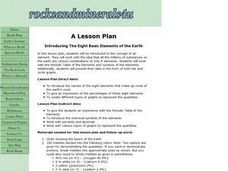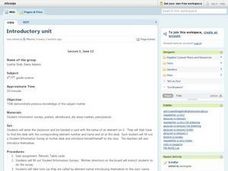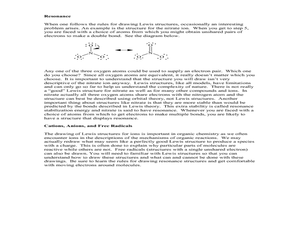Curated OER
Science 9 Unit 3 Worksheet
In this chapters 2 and 3 science guided reading worksheet, students read corresponding material pertaining chemical reactions and the periodic chart answering 40 fill in the blank questions.
Curated OER
Crystals: What Are They and What Holds Them Together
Students are introduced to the characteristics of crystals and what keeps them together. Using the Periodic Table, they examine the various elements and develop a model of an atom. In groups, they place sugar and salt in petri dishes...
Curated OER
Clay Atoms-Taming Our Fear Of The Invisible
Young scholars create atoms with clay by using different colors to represent the protons, neutrons and nucleus. In this creative lesson students use clay to learn about atoms and see how they apply to the periodic table.
Curated OER
Naturally Magnetic Elements
Students explore naturally magnetic elements. For this magnets lesson, students examine the periodic table of elements. Students discover the parts of an atom and determine which three elements are magnetic.
Curated OER
Arranging the Elements
Students describe how elements are arranged in the periodic table. They compare metals, nonmetals, and metalloids based on their properties and on their location in the periodic table. Finally, students identify and describe the...
Curated OER
CEENBot Soccer
Students research the history and uses of the different elements in the periodic table. In this chemistry lesson, students explain the significance of an element's valence electrons. They create a multimedia presentation of an element...
Curated OER
Eight Basic Elements of the Earth
Students identify the concept of an element and work with an idea that all of the millions of substances on the earth are various combinations of only 8 elements. They work with the Periodic Table of the Elements and symbols of the...
Curated OER
What is Radon?
Learners read an article about radon and its properties. They examine a periodic table and identify the numbers surrounding an element. They discuss the harmful and helpful effects of radiation.
Curated OER
Roll or Attendance
Students stand for roll call in designated spots painted by the teacher. They stand on the alphabet, numbers, periodic table, and keyboard.
Curated OER
Element Project
Ninth graders review and discuss the Periodic table and its 53 elements. They choose one element to become an expert on and then create a written Report in the form of a poster about their choosen element to be presented to the class.
EngageNY
The Motion of the Moon, Sun, and Stars—Motivating Mathematics
What does math have to do with the behavior of the earth and sun? Learn how the movement of celestial bodies has influenced the development of trigonometry. Scholars connects the details in mathematics to their real-world meaning.
Curated OER
Chemistry
Students identify elements on the periodic table and how to read it. They create their own chart for alkali metals and alkaline earth metals. They are evaluated based on a rubric.
Curated OER
Who Dirtied The Water/Clean Water: Is It Drinkable?
Students enter the room, receive a film canister that contains materials that be added to the dirty water bell jar. They record on their data table who or what is doing the adding and the actual substance that has been added to the bell...
EngageNY
Addition and Subtraction Formulas 2
Knowing the addition formulas allows for the calculations of double and half formulas. The fourth installment of 16 has the class use the addition formula to develop the double angle trigonometric formulas. Using the double formula,...
Curated OER
Naming Elements and The Periodic Chart
Students will enter the classroom and be handed a card with the name of an element on it. They will then have to find the desk with the corresponding element number and name and sit at this desk. Each student fills out a Student...
Curated OER
Do You Have Change?
Students analyze data and complete a worksheet about land use change in a coastal region. In this land use lesson, students discuss events that cause land use changes in coastal areas. They construct a change table to summarize data on...
Curated OER
Building Patterns Constantly
Pupils are introduced to some number patterns using buildings constructed with squares. They construct tables of patterns and finding the recurrence rule for a simple pattern where the increase from term to term is a constant.
Curated OER
Classifying Functions
Eleventh graders sort different types of functions including rational, periodic, exponential, polynomial, quadratic, logarithmic and linear using "function cards." The functions are displayed in multiple representations including...
Virginia Department of Education
Metals, Nonmetals, and Metalloids
How can one easily classify metals, nonmetals, and metalloids? Pupils answer this question as they experiment with unknown substances and perform tests on conductivity, brittleness, and malleability to determine which unknown belongs in...
Virginia Department of Education
Properties of Compounds and Chemical Formulas
Young chemists have unknown compounds they need to sort. Performing three different tests on each, the chemical behaviors they observe become the basis for data analysis.
Chemistry Teacher
Metals, Nonmetals, and Metalloids Lab
What an exciting way to introduce your blossoming chemists to the world of metals, nonmetals, metalloids, and polymers! Here is a lab activity that is designed to allow pupils the opportunity to visualize the reaction of metals,...
Curated OER
The Photoelectric Effect in Photocells
Illuminate your physics class with this examination of a photovoltaic cell. Teach the structure and operation of the device using a diagram. Then make a human-powered, larger-than-life sized model of a PV cell. Learners become electrons...
Curated OER
The Alkaline Earth Metals
Students investigate the characteristics of alkaline earth metals. In this alkaline earth metals lesson plan, students experiment with a variety of alkaline earth metal compounds and perform tests to observe their properties. Students...
Curated OER
Drawing Lewis Structures
In this drawing Lewis structures worksheet, students read about the 5 steps taken to draw Lewis structures for atoms and molecules. These include identifying the valence electrons, placing pairs of electrons between atoms to be bonded,...
Other popular searches
- Chemistry Periodic Table
- Periodic Table of Elements
- Periodic Table Worksheet
- Periodic Table Review Game
- Periodic Table Trends
- The Periodic Table
- Mendeleev Periodic Table
- Chemistry Periodic Table Lab
- Periodic Table Basics
- Lesson Plan Periodic Table
- Science Periodic Table
- Alien Periodic Table

























